We begin a proof of Riemann mapping theorem, which will not be
concluded. But this is the now standard proof, given in many
textbooks, so finish it off by reading. In the proof, a proper simply
connected, connected open subset U of C is given. If there is a
biholomorphic mapping from U to D1(0), then (since we know
Aut(D1(0) very well now) we can require that the mapping
take a selected point p in U to 0 in D1(0), and we can also
ask that the derivative of this mapping at p be real. The Schwarz
Lemma also suggests that we make this derivative as large as possible,
so that the image will be all of the disc (this is just a
suggestion!). Many proofs of the RMT create a sequence of functions
{fn}, and the desired biholomorphic mapping is the limit of
the sequence. We should try to see when such sequences must
have a limit.
Problem Given a "collection" of functions F, when is it true
that every sequence in that collection has a subsequence which
converges uniformly?
A good collection of examples is
important. Our function space for examples was C[0,1], the continuous
functions on the unit interval. For simplicity, we will consider
real-valued continuous functions.
|
Example 1 The family of functions is the sequence
fn(x)=n. Certainly this sequence does not converge
uniformly. From this we learn that we'd better require that our family
of functions is bounded (sometimes called uniformly bounded):
that is, there is B>0 so that for all f's in F, we know that
|f(x)|<=B. The graphs of f(x) are between y=-B and y=B.
|
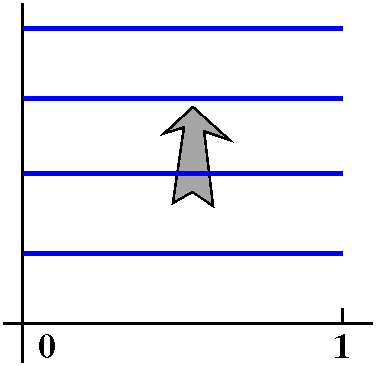
|
|
Example 2 The family of functions is the
sequence fn(x)=sin(nx). I claim that this sequence does
not converge uniformly, and, indeed, that it has no subsequence
which converges uniformly. Well, just look at x=0 and what happens
near 0. If there is a function g which is a limit of a subsequence of
the fn's, then I certainly know that g(0)=0 since all of
the fn's have value 0 at 0. Notice that for some very
large n, |fn(x)-g(x)|<1/2 for x's near 0. Well, since
g(0)=0, I bet that we can select an interval of x's near 0 ("some
[0,D] for D>0") so |g(x)|<1/2. Then for large enough n and for
those x's, |fn(x)|<=|fn(x)-g(x)|+|g(x)|<1/2+1/2=1. But, golly, fn has
period 2Pi/n. For large n's, this period certainly fits inside
[0,D]. And the values of sine on a period are [-1,1], so there is
no uniformly convergent subsequence of this sequence of
functions. The sequence of functions wiggles too much.
| 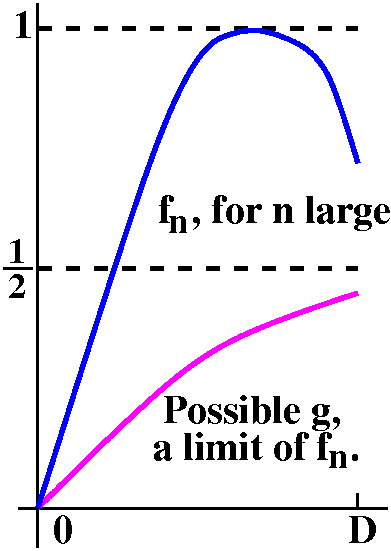
|
In general, if a sequence of functions converges uniformly to a limit
function, the limit function's wiggle must be close to the wiggle of
almost all of the sequence. Of course, it would be helpful if the word
or idea of wiggle were made more precise, and, in a real
variables courses, I am sure that you will all learn about the
oscillation of a function. For this course, we just need the following definition.
Definition F is equicontinuous at x0 if any e>0,
there exists d>0, such that for any f in F, if
|x-x0|<d, then
|f(x)-f(x0)|<e.
A true fact (what's a false fact?) is that a collection of continuous
functions defined on a compact metric space which is equicontinuous at
every point is actually uniformly equicontinuous (e doesn't
depend on x0). This follows from standard compactness
arguments.
Now we can state a famous theorem which says the necessary
conditions mentioned are actually sufficient. To me, this result is
not obvious. It needed consideration of many more examples than the
few we have considered.
Theorem (Arzela-Ascoli) If F is a
subset of C[0,1] which is bounded and (uniformly) equicontinuous, then
every sequence in F has a uniformly convergent subsequences.
You should try to prove this yourself, even if you've heard or read or
have sat through (!) a proof. Just look at a {xn}
which is dense in [0,1], and create a subsequence of any sequence in F
(diagonally selected!) converge everywhere uniformly.
How can we guarantee or "force" that a collection of functions is
equicontinuous at (even) one point? One simple condition follows:
Suppose F is a subset of C[0,1], and suppose that all of the functons
in F are differentiable. IF there is a constant K
so that |f´(x)|<=K then F is equicontinuous. This follows from
the Mean Value Theorem. MVT says f(b)-f(a)=f´(c)(b-a). Now if
|b-a|<e/K, |f(b)-f(a)| will certainly be less than e. So d can be
e/K, the same for all of the f's in F.
This is not the only way to verify equicontinuity, of course. One can
ask for uniform Lipschitz conditions: there's q>0 and r>0
so that |f(b)-f(a)|<=r|b-a|q (think of sqrt(x) and
companions on [0,1]: certainly not Lipschitz (a q=1 condition won't be
satisfied near 0 but a q=1/2 will be) and certainly not
differentiable. There was some discussion
of this earlier in the diary.
Notice that we can put together intervals to get convergence on all of
R. For example, here is a result depending A-A for closed bounded
intervals:
Suppose F is a collection of continuous functions on R and that we
know F is bounded on any compact interval in R, and also that F is
uniformly equicontinuous on any compact interval in R. Then every
sequence in f has a uniformly convergent subsequence.
Why is this true? Take any sequence of functions in F. We apply A-A on
[-1,1] and get a uniformly convergence subsequence. Then consider
this subsequence on [-2,2] and get a subsequence of that subsequence,
and then ... [-n,n] ... and choose the final subsequence to be a
diagonal subsequence of this sequence of subsequences. The result is a
sequence which converges uniformly on any compact subset of R (not
necessarily on R itself, though). So we use the sigma-compactness of
R. Any subset of C is also sigma-compact, so the same approach will
be successful there.
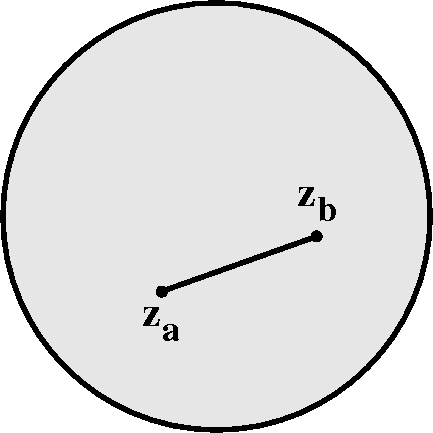 What happens when we consider holomorphic functions?
For example, suppose we have a function f holomorphic in a disc, with
|f´(z)|<=K. If za and zb are in the
disc, then
f(zb)-f(za)=INTpathf´(z) dz.
We can take the path to be, for example, a straight line
segment from za to zb. But ML then gives
|f(zb)-f(za|<=K|zb-za|,
a Lipschitz estimate, so a family of holomorphic functions whose
derivatives have uniformly bounded modulus would also be (uniformly)
equicontinuous. And since uniformly convergent sequences of
holomorphic functions have holomorphic limits, we see that the
limiting continuous function guaranteed by A-A is here also
holomorphic.
What happens when we consider holomorphic functions?
For example, suppose we have a function f holomorphic in a disc, with
|f´(z)|<=K. If za and zb are in the
disc, then
f(zb)-f(za)=INTpathf´(z) dz.
We can take the path to be, for example, a straight line
segment from za to zb. But ML then gives
|f(zb)-f(za|<=K|zb-za|,
a Lipschitz estimate, so a family of holomorphic functions whose
derivatives have uniformly bounded modulus would also be (uniformly)
equicontinuous. And since uniformly convergent sequences of
holomorphic functions have holomorphic limits, we see that the
limiting continuous function guaranteed by A-A is here also
holomorphic.
Notice, please, we are using a sort of Mean Value inequality,
which is certainly valid under these circumstances. We aren't using an
equality form of MVT since that's not true.
It is amazing and wonderful and powerful that the requirements of
Arzela-Ascoli can be combined in a simpler hypothesis for holomorphic
functions.
Theorem (called Montel's Theorem)
Suppose U is open, F is a collection of functions which are
holomorphic on U, and for any K compact in U,
supf in F||f||K is finite (so the
modulus of functions in F is bounded on any compact set).
Then every sequence in F has a subsequence which converges
uniformly on compact subsets.
The classical name for such F's is a normal family. These F's
are subsets of the holomorphic functions whose closure is compact
("precompact" sets of holomorphic functions).
Proof U is the increasing union of compact sets Kn.
We proved that
||f´||K<=(1/s)||f||Ks for
sufficiently small positive s. So combine this with the previous
observation, and we see that an F which is bounded on compact sets is
also uniformly equicontinuous on compact sets. So A-A applies. And
sigma-compactness also guarantees the existence of a (locally)
uniformly convergent sequence of holomorphic functions in F. The limit
function will be holomorphic.
(Not) finishing the proof of RMT: start with a well-chosen f on U. The
hypothesis of simply connected insures that holomorphic square roots
of non-zero holomorphic functions exist. This is used to create the
initial f and then to continue with a sequence of
fn's. Montel's Theorem is used to guarantee a limit, and
Hurwitz's Theorem (limits of 1-1 holomorphic functions are either
constant or 1-1) to show that the limit is not constant. And the
Schwarz Lemma essentially guarantees that the whole disc
D1(0) is filled up by the image of U. Please read one of the classical proofs. The text's
version is in section 6.7.
For what follows we need one more classical result called the
Schwarz Reflection Principle.
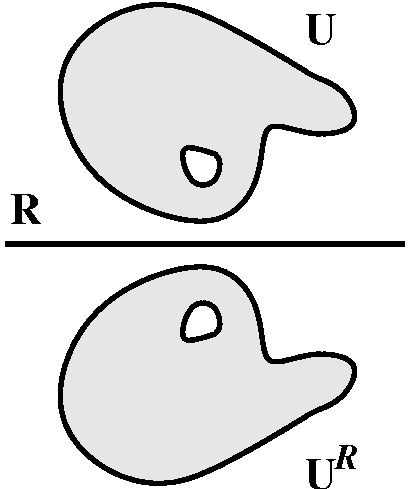 Schwarz Reflection (baby version) Suppose that U is open and
connected in C, and f(z)=f(x+iy)=u(x,y)+iv(x,y) is holomorphic in
U. If UR is the collection of "reflected" z's in U
(that is, all the zbar's for z in U), then the function
g(z)=[f(zbar)bar is holomorphic in
UR.
Schwarz Reflection (baby version) Suppose that U is open and
connected in C, and f(z)=f(x+iy)=u(x,y)+iv(x,y) is holomorphic in
U. If UR is the collection of "reflected" z's in U
(that is, all the zbar's for z in U), then the function
g(z)=[f(zbar)bar is holomorphic in
UR.
Why is this true? One way to think about this is to realize that f(z)
near z0 in U is the sum of a convergent power series. The
mapping z-->zbar is certainly continuous
(although it equally certainly is not holomorphic). But then the
series
SUMn=0INFan(z-z0)n
becomes the series
SUMn=0INF{an}bar(z-{z0}bar)n
upon the stated reflection, and this is a convergent power
series in z, indeed.
Another way to verify holomorphicity is just to realize that
g(z)=u(x,-y)-iv(x,-y). The several variable Chain Rule from calculus
will show that g satisfies the Cauchy-Riemann equations.
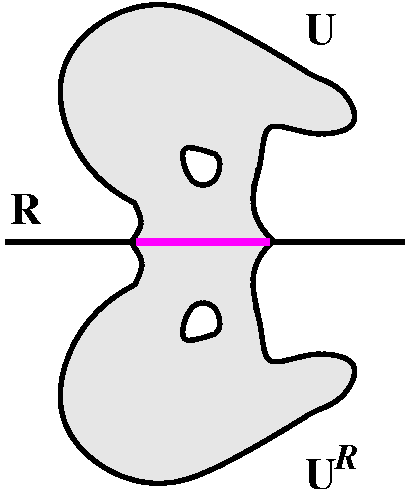 Schwarz Reflection (adolescent version) Suppose that U is open and
connected in H, the open upper halfplane (z's so that
Im z>0). Also suppose that the boundary of U contains an
interval I of the real line, R. Suppose that f is holomorphic in U and
has real continuous boundary values on I: that is,
limz-->xf(z)=Q(x) exists (x is in I and z is in U) and Q
is continuous in I. Then define V to be the union of U and
UR (as defined before) and I also. Let g(z) be f(z)
for z in U, [f(zbar)]bar for z in
UR, and Q(x) for x in I. Then g is holomorphic in
V.
Schwarz Reflection (adolescent version) Suppose that U is open and
connected in H, the open upper halfplane (z's so that
Im z>0). Also suppose that the boundary of U contains an
interval I of the real line, R. Suppose that f is holomorphic in U and
has real continuous boundary values on I: that is,
limz-->xf(z)=Q(x) exists (x is in I and z is in U) and Q
is continuous in I. Then define V to be the union of U and
UR (as defined before) and I also. Let g(z) be f(z)
for z in U, [f(zbar)]bar for z in
UR, and Q(x) for x in I. Then g is holomorphic in
V.
Proof Certainly the Baby Version of Schwarz Reflection shows
that g is holomorphic in U and in UR and we need to
check what happens near I. But g is continuous in all of V. If we can
show that the integral of g around a rectangle with sides parallel to
the coordinate axes is 0, we are done (Morera!). But it's enough to
consider a rectangle with one side on the x-axis. We can move it
up slightly, and the integral is 0 (Cauchy!). This integral is
continuous in the slight movement, so the desired rectangular
contour integral must be 0.
This sort of argument was part of an earlier homework problem and a
number of students recognized it. The hypotheses imply that the
original mapping of f sort of sits on one side of the image R inside
the image C. The reflection principle can be used in many contexts
because both the domain and the image R's can be changed into many
different curves by conformal mappings. This is used, for example, to
analyze the automorphism groups of complicated domains such as an
annulus, and can also be used to construct the elliptic modular
function, a very important classical holomorphic function with uses in
number theorem and hyperbolic geometry.
The adult version of the Schwarz Lemma weakens the hypothesis
in the adolescent version in one wonderful way. We ask that the
limz-->xf(z)=Q(x) still exist and be real, but no
additional conditions on Q are needed. Notice that one consequence
of the existence of the limit, using the adult version, is that the
resulting Q turns out to be real analytic: certainly this is
not obvious. It is not even obvious in the adolescent version, where
there is an almost magical transition from "Q is continuous" to "Q is
real analytic". This result is what's important in the very last
discussion of the course. The proof of the adult verions uses the
solution of the Dirichlet Problem and the consequence that continuous
functions which have the mean value property must be harmonic. This is
discussed in the textbook. See Theorem 7.5.2 in section 7.5.
The very last, very final, wonderful conclusion of the course is the Lewy example of a simple PDE with
no solutions.
Also available is a direct discussion of
the Mittag-Leffler and Weierstrauss Theorems, results guaranteeing
the existence of holomorphic and meromorphic functions with strictly
prescribed behavior. This was proofread by Mr. Castro and Ms. Naqvi,
whose efforts I appreciated.
And, indeed, I appreciated the work of all the students in the course:
thank you. Here is information
about the final exam.


 What happens when we consider holomorphic functions?
For example, suppose we have a function f holomorphic in a disc, with
|f´(z)|<=K. If za and zb are in the
disc, then
f(zb)-f(za)=INTpathf´(z) dz.
We can take the path to be, for example, a straight line
segment from za to zb. But ML then gives
|f(zb)-f(za|<=K|zb-za|,
a Lipschitz estimate, so a family of holomorphic functions whose
derivatives have uniformly bounded modulus would also be (uniformly)
equicontinuous. And since uniformly convergent sequences of
holomorphic functions have holomorphic limits, we see that the
limiting continuous function guaranteed by A-A is here also
holomorphic.
What happens when we consider holomorphic functions?
For example, suppose we have a function f holomorphic in a disc, with
|f´(z)|<=K. If za and zb are in the
disc, then
f(zb)-f(za)=INTpathf´(z) dz.
We can take the path to be, for example, a straight line
segment from za to zb. But ML then gives
|f(zb)-f(za|<=K|zb-za|,
a Lipschitz estimate, so a family of holomorphic functions whose
derivatives have uniformly bounded modulus would also be (uniformly)
equicontinuous. And since uniformly convergent sequences of
holomorphic functions have holomorphic limits, we see that the
limiting continuous function guaranteed by A-A is here also
holomorphic.
 Schwarz Reflection (baby version) Suppose that U is open and
connected in C, and f(z)=f(x+iy)=u(x,y)+iv(x,y) is holomorphic in
U. If UR is the collection of "reflected" z's in U
(that is, all the zbar's for z in U), then the function
g(z)=[f(zbar)bar is holomorphic in
UR.
Schwarz Reflection (baby version) Suppose that U is open and
connected in C, and f(z)=f(x+iy)=u(x,y)+iv(x,y) is holomorphic in
U. If UR is the collection of "reflected" z's in U
(that is, all the zbar's for z in U), then the function
g(z)=[f(zbar)bar is holomorphic in
UR.
 Schwarz Reflection (adolescent version) Suppose that U is open and
connected in H, the open upper halfplane (z's so that
Im z>0). Also suppose that the boundary of U contains an
interval I of the real line, R. Suppose that f is holomorphic in U and
has real continuous boundary values on I: that is,
limz-->xf(z)=Q(x) exists (x is in I and z is in U) and Q
is continuous in I. Then define V to be the union of U and
UR (as defined before) and I also. Let g(z) be f(z)
for z in U, [f(zbar)]bar for z in
UR, and Q(x) for x in I. Then g is holomorphic in
V.
Schwarz Reflection (adolescent version) Suppose that U is open and
connected in H, the open upper halfplane (z's so that
Im z>0). Also suppose that the boundary of U contains an
interval I of the real line, R. Suppose that f is holomorphic in U and
has real continuous boundary values on I: that is,
limz-->xf(z)=Q(x) exists (x is in I and z is in U) and Q
is continuous in I. Then define V to be the union of U and
UR (as defined before) and I also. Let g(z) be f(z)
for z in U, [f(zbar)]bar for z in
UR, and Q(x) for x in I. Then g is holomorphic in
V.